Market Brief
The Great British Pound is not doing so great today, following on from this morning’s UK retail sales data and the overnight Gfk Consumer Confidence data that both showed worse than expected results.
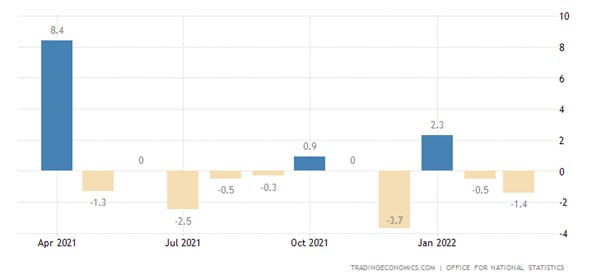

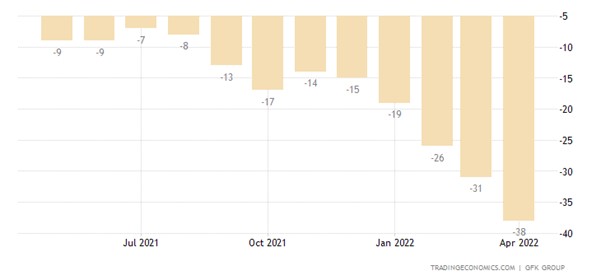

The Gfk confidence indicator has fallen sharply over the last 5 months and is now at its lowest level since 2008. The main drivers for this lack of confidence are the higher inflation and rate hike cycle which is adding to the cost of living.
Just as the UK weather was improving in March, we got hit with a flurry of snow. As a result, we have all been staying put and not exploring, and why would we when petrol is so expensive, you must spend 30% more to fill up the tank before you can travel anywhere? And in the Southeast of England, which is arguably the most affluent area of the country, the petrol stations are invariably shut due to supply disruptions. All of this is adding to the pullback in retail spending which is going to affect the UK GDP going forwards.
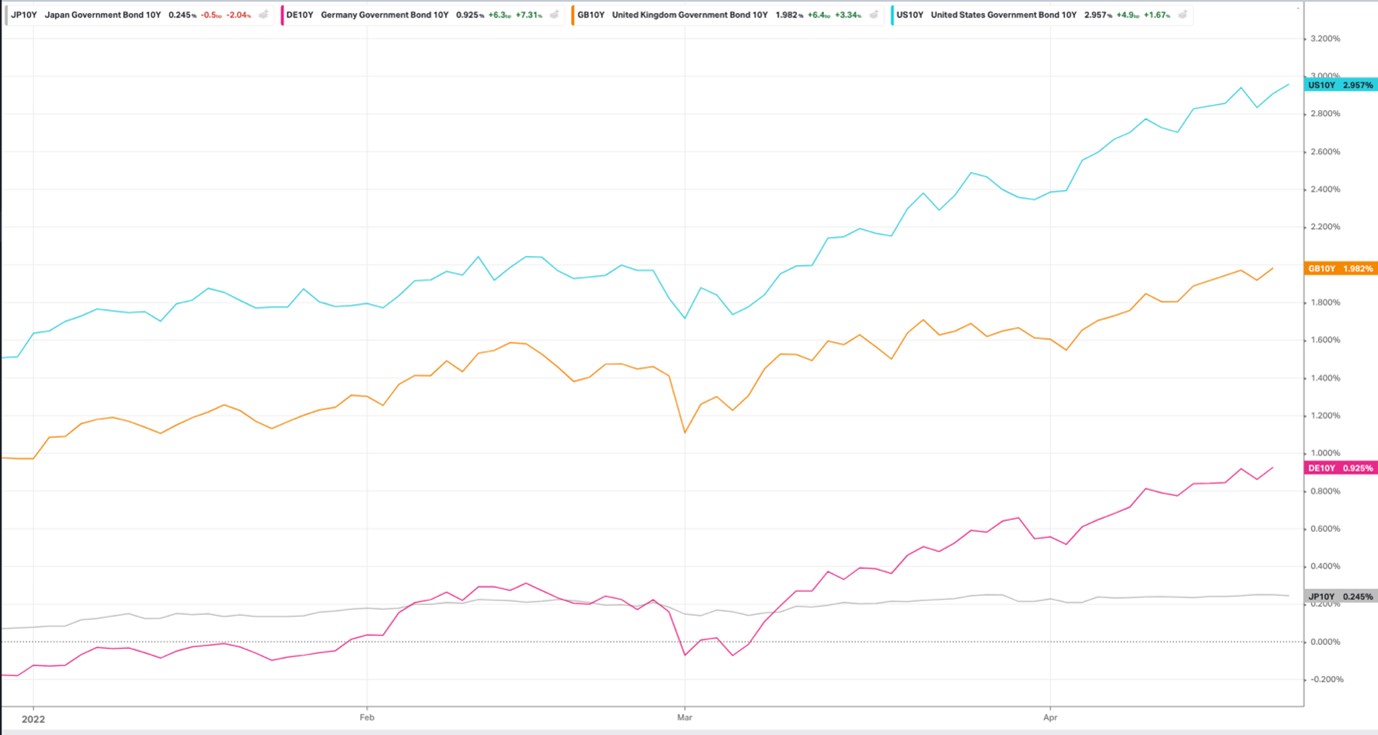

After the IMF speeches from the heads of the BoE, ECB and Fed, the benchmark yields are all higher this morning. Rate hike expectations for the ECB were pulled higher as talk of a July rate hike became 1 step closer to being a reality.
See real-time quotes provided by our partner.
Looking at the GBPUSD chart there is very little that makes sense until you get to the weekly time frame, as we have been chopping around the 1.3000 level for a couple of weeks. Now that the price action has broken out of that range we can look below for levels of liquidity and support. The 1.2800 looks like the most interesting level to target and to then look for a possible reversal when we get back into the September range printed in 2020. This could accelerate lower too, as the sentiment indicator on the ActivTrader platform shows that 78% of traders are trying to go long cable.
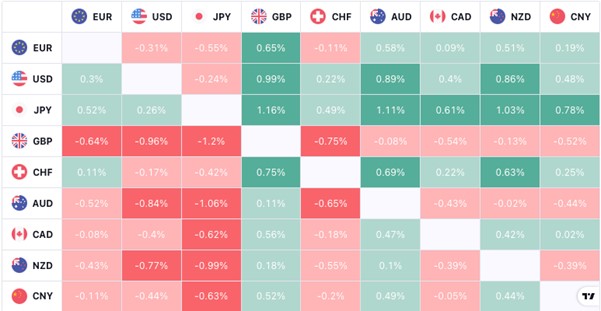

The forex heatmap shows that the pound is currently the weakest currency and that the yen is the strongest.
See real-time quotes provided by our partner.
During the Asia-Pac session Japan’s Flash Manufacturing PMI came in better than expected and the previous reading was revised higher. Inflation was also higher YoY, but it came in as expected at 1.2%. This level of inflation is the highest seen in 3.5 years. The USDJPY has been surging higher and recently took out some weekly highs last printed in 2002. We should expect some profit taking to occur and after Fed Chair Powell didn’t add anything to the monetary policy guidance yesterday, we could see a pullback into the end of today.
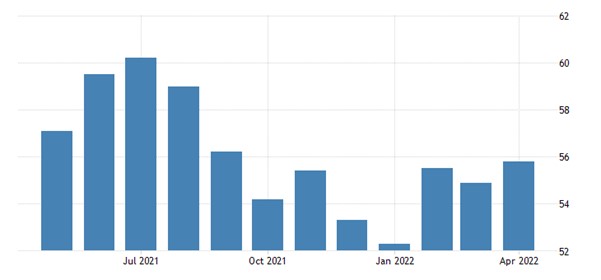

According to the S&P Global report released this morning, the Eurozone’s Purchasing Manager’s Index (PMI) Composite Output Index, which measures the performance made by service and manufacturing sectors jointly, rose in April from March, reaching 55.8 from 54, its seven-month high.
In the euro area, the Services PMI Activity Index also saw a monthly increase, going up to its 8-month high of 57.7. Manufacturing underperformed, as the Output Index fell to its 22-month low of 50.4, and the Manufacturing PMI fell to its 15-month low of 55.3.
See real-time quotes provided by our partner.
The EURUSD H4 chart shows that the range formed from March 8th, 2022, to the beginning of April, is now likely to fully break to the downside. The attempt yesterday to get price action back into the range and to test the 1.1000 level has been fully reversed, which is indicating the initial reaction to the July rate hike, was a false flag and designed to trap traders into a long position. The ActivTrader sentiment indicator shows that 79% of traders are long and they probably have stops below the 1.07570 level and beyond. I will be waiting for that liquidity below the 1.07570 to be removed and then we can start looking for the next trade as we have missed the boat on this current move.
Today is full of Flash PMI data so I am expecting some headline risk and volatility which would then set up the trading levels for next week.
© 2020 YouTrading UK - Leaders in Trader Training.
| Cookie | Duration | Description |
|---|---|---|
| __cfduid | 1 month | The cookie is used by cdn services like CloudFare to identify individual clients behind a shared IP address and apply security settings on a per-client basis. It does not correspond to any user ID in the web application and does not store any personally identifiable information. |
| _wpfuuid | 11 years | This cookie is used by the WPForms WordPress plugin. The cookie is used to allows the paid version of the plugin to connect entries by the same user and is used for some additional features like the Form Abandonment addon. |
| cf_use_ob | This cookie is set by the provider Cloudflare content delivery network. This cookie is used for determining whether it should continue serving "Always Online" until the cookie expires. | |
| cookielawinfo-checbox-analytics | 11 months | This cookie is set by GDPR Cookie Consent plugin. The cookie is used to store the user consent for the cookies in the category "Analytics". |
| cookielawinfo-checbox-functional | 11 months | The cookie is set by GDPR cookie consent to record the user consent for the cookies in the category "Functional". |
| cookielawinfo-checbox-others | 11 months | This cookie is set by GDPR Cookie Consent plugin. The cookie is used to store the user consent for the cookies in the category "Other. |
| cookielawinfo-checkbox-advertisement | 1 year | The cookie is set by GDPR cookie consent to record the user consent for the cookies in the category "Advertisement". |
| cookielawinfo-checkbox-necessary | 11 months | This cookie is set by GDPR Cookie Consent plugin. The cookies is used to store the user consent for the cookies in the category "Necessary". |
| cookielawinfo-checkbox-performance | 11 months | This cookie is set by GDPR Cookie Consent plugin. The cookie is used to store the user consent for the cookies in the category "Performance". |
| viewed_cookie_policy | 11 months | The cookie is set by the GDPR Cookie Consent plugin and is used to store whether or not user has consented to the use of cookies. It does not store any personal data. |
| Cookie | Duration | Description |
|---|---|---|
| YSC | session | This cookies is set by Youtube and is used to track the views of embedded videos. |
| Cookie | Duration | Description |
|---|---|---|
| _ga | 2 years | This cookie is installed by Google Analytics. The cookie is used to calculate visitor, session, campaign data and keep track of site usage for the site's analytics report. The cookies store information anonymously and assign a randomly generated number to identify unique visitors. |
| _gid | 1 day | This cookie is installed by Google Analytics. The cookie is used to store information of how visitors use a website and helps in creating an analytics report of how the website is doing. The data collected including the number visitors, the source where they have come from, and the pages visted in an anonymous form. |
| Cookie | Duration | Description |
|---|---|---|
| _fbp | 3 months | This cookie is set by Facebook to deliver advertisement when they are on Facebook or a digital platform powered by Facebook advertising after visiting this website. |
| fr | 3 months | The cookie is set by Facebook to show relevant advertisments to the users and measure and improve the advertisements. The cookie also tracks the behavior of the user across the web on sites that have Facebook pixel or Facebook social plugin. |
| IDE | 1 year 24 days | Used by Google DoubleClick and stores information about how the user uses the website and any other advertisement before visiting the website. This is used to present users with ads that are relevant to them according to the user profile. |
| test_cookie | 15 minutes | This cookie is set by doubleclick.net. The purpose of the cookie is to determine if the user's browser supports cookies. |
| VISITOR_INFO1_LIVE | 5 months 27 days | This cookie is set by Youtube. Used to track the information of the embedded YouTube videos on a website. |
| Cookie | Duration | Description |
|---|---|---|
| _gat_UA-42160853-2 | 1 minute | No description |
| cf_ob_info | No description | |
| CONSENT | 16 years 8 months 3 days 6 hours 2 minutes | No description |